
Their designs help them hide, hunt, or warn other animals to steer clear.
But some snakes take it to another level.
They sport markings that are truly eye-catching.
And you might be surprised just how beautiful and complex these patterns get.
If you enjoy learning about amazing-looking animals, all of the stunning snake species below will definitely catch your attention.
9 Snakes With Stunning Patterns
This list is in no particular order, since all of the following snakes are beautiful. Which one impresses most will differ from one person to the next. Personally, my favorite is the sunbeam snake, since it’s usually covered in mud so you rarely get to see it’s full beauty on display.
1. Green Tree Python
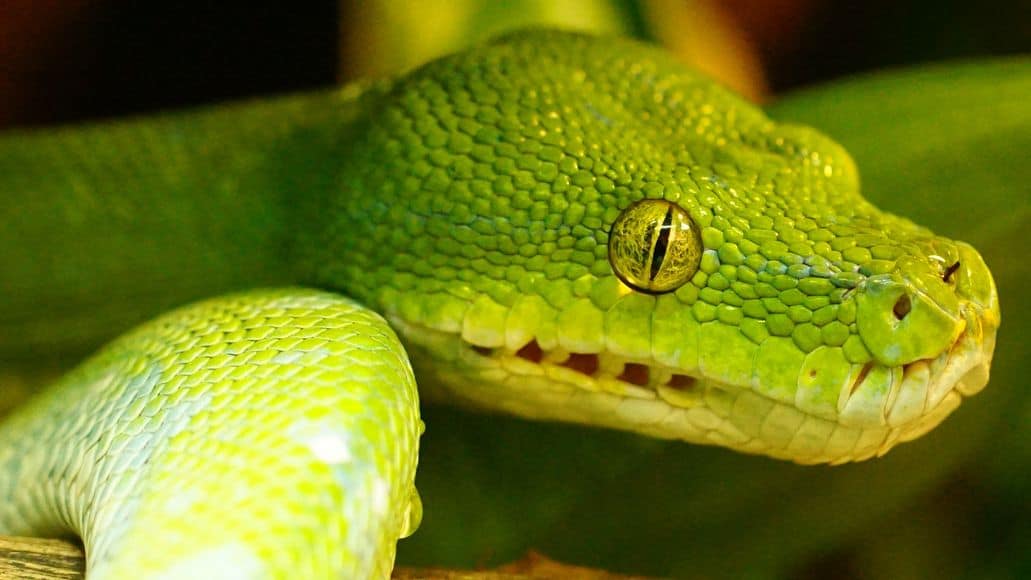
When you see a Green Tree Python, it’s hard not to be impressed by its bright color and pattern. This snake is famous for its emerald green body, which helps it blend into leaves and branches.
Sometimes, you’ll spot yellow, blue, or white markings along its back. You’re likely to find the Green Tree Python resting in trees, coiled up on branches and almost looking like a vine. Its unique way of wrapping its body really shows off the pattern on its scales.
Young Green Tree Pythons don’t start out green—they’re actually bright yellow or red at first and slowly change color as they grow. This color change is pretty fascinating to watch over time. If you look closely, you’ll see their scales even shine a little in the light, making them one of the most eye-catching snakes around.
2. Mandarin Rat Snake

If you love bright and interesting snake patterns, the Mandarin Rat Snake will grab your attention right away. Its body shows off bold black bands and vivid orange-yellow bands that make it look special. Sometimes, you’ll notice white or gray mixed into its scales.
This snake comes from Asia, especially places like China, Vietnam, and Taiwan. It prefers to live in forests and hilly areas where it can hide among leaves and rocks. The appearance of this snake isn’t just beautiful—it helps it blend into the ground, keeping it safe from predators.
Even though it looks flashy, the Mandarin Rat Snake isn’t venomous and usually acts shy around people. If you ever see this species, you might find its smooth, glossy scales and clear pattern really appealing.
This snake is popular with reptile keepers because of its calm behavior and attractive coloring. It is also a wonderful subject for photographers. If you like taking photos of snakes like this one, check out out article of tips for photographing snakes in the wild.
3. Coral Snake
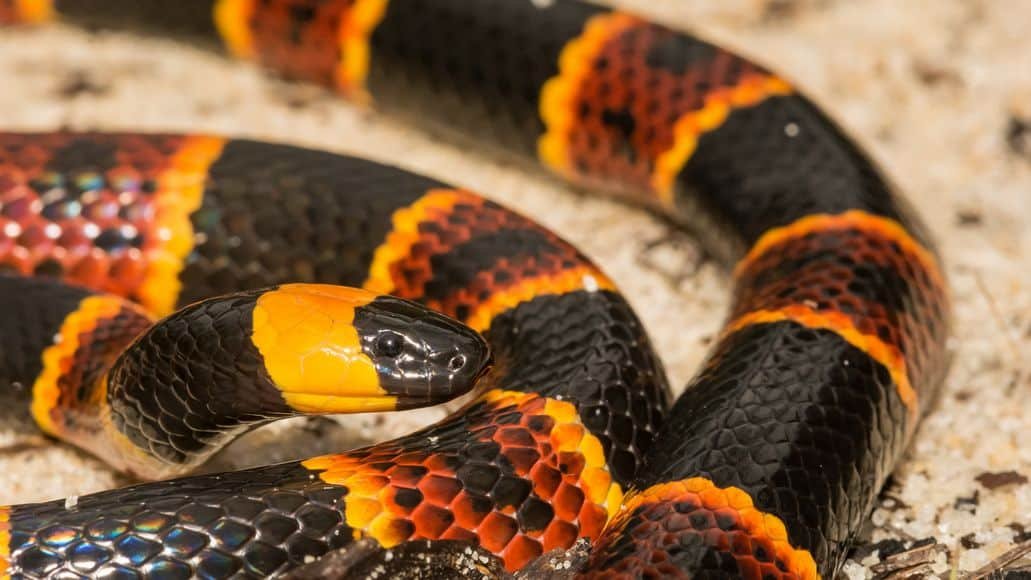
When you spot a coral snake, its bright pattern is pretty unforgettable. These snakes show off rings of red, yellow (or white), and black all along their bodies. The pattern is bold and stands out in the wild.
You might find coral snakes in parts of North and South America, and their unique coloring looks very different from many other snakes. The bands are always clean and easy to notice. People sometimes mix up coral snakes with non-venomous lookalikes like the milk snake and the king snake.
The saying “red touch yellow, kill a fellow” can help you tell them apart in the U.S., where real coral snakes have red and yellow bands next to each other. Coral snakes prefer to hide under leaves or logs, so you don’t see them often.
Their beautiful bands warn predators that they’re dangerous, so most animals leave them alone. If you see one, it’s best to enjoy its colors from a safe distance.
4. Jungle Carpet Python

When you see a Jungle Carpet Python, you’ll notice its bold patterns right away. This snake has black markings on a yellow or gold background, creating a look almost like a living mosaic.
You’ll find these snakes in the rainforests and woodlands of Australia. Their patterns help them blend in with leaves and branches, keeping them hidden from predators.
Many people keep Jungle Carpet Pythons as pets because of their stunning appearance. If you ever meet one, you’ll see that every snake has a unique pattern—no two are exactly the same.
Their color can actually get brighter as they grow older. Sunlight may make their scales look even more vibrant, whether they’re in the wild or in captivity.
You’re also likely to notice their slender bodies and smooth movements, which add to their striking looks.
5. Reticulated Python
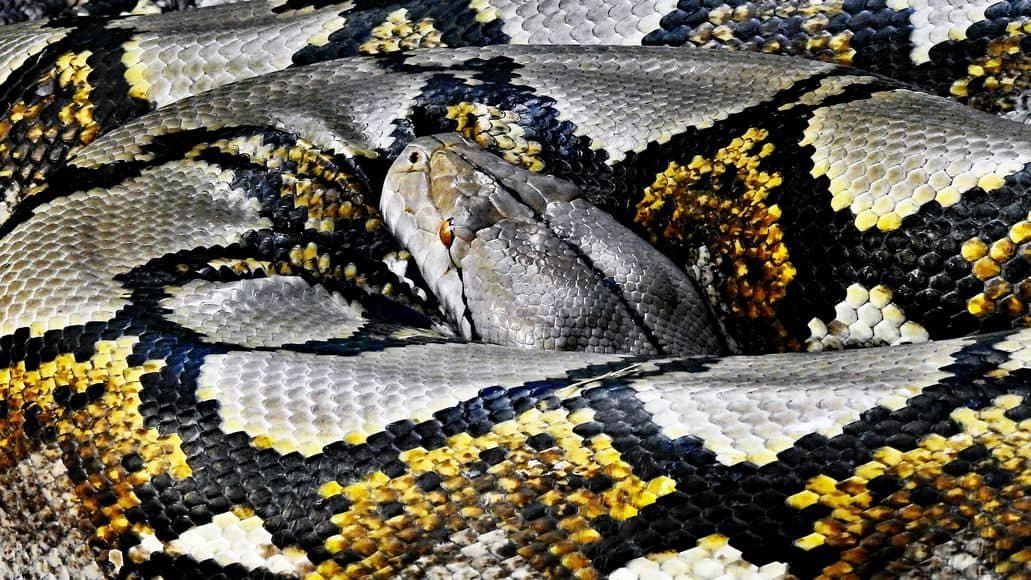
When you see a reticulated python, its beautiful pattern is hard to miss. The scales have a complex net-like design with gold, black, and white colors woven together.
These patterns help the snake blend into the tropical forests where it lives. You might spot triangular shapes and diamond patterns running along its long body.
Every reticulated python has its own mix of colors and shapes, making each one unique. The way the light hits their scales can make the colors look even brighter.
These snakes are the longest in the world, sometimes reaching over 20 feet. Their size, combined with their detailed pattern, makes them stand out among other snakes. If you ever see one in the wild or at a zoo, you’re likely to remember its striking look.
6. Milk Snake
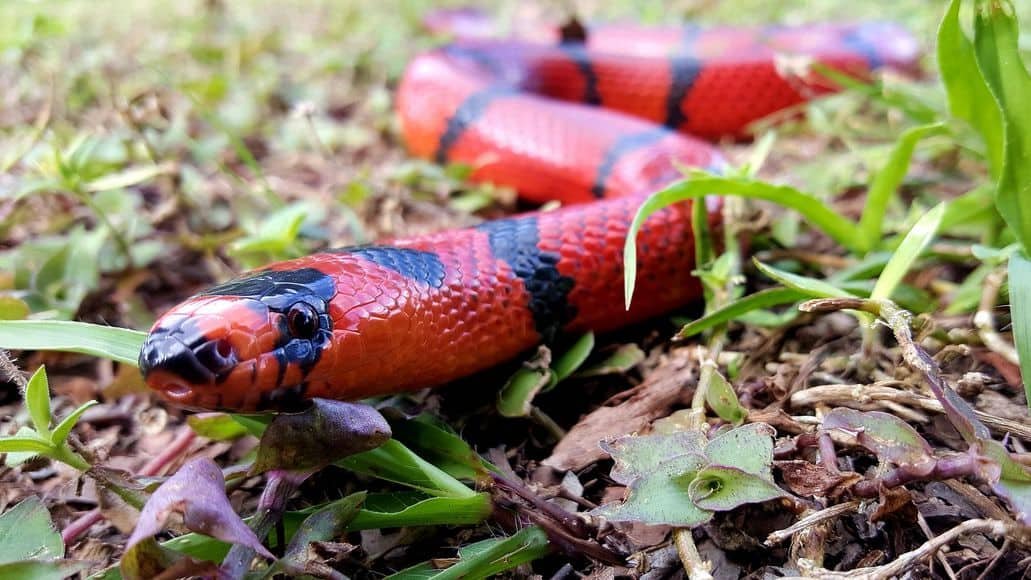
When you look at a milk snake, you’ll notice its bold colors first. Its body is covered in bright red, black, and yellow or white bands.
These stripes wrap around its body in a repeating pattern. You might find the way these colors are arranged interesting, since the pattern on each snake is a little different.
The bands are always clear and crisp, helping them stand out against the background where they live. You can find milk snakes in North and South America. They hide under logs, leaves, and rocks. Their colors help them scare off predators by looking like the dangerous coral snake.
Even though they may look scary, milk snakes aren’t venomous. If you ever see one, you might be surprised by how small and slender they actually are compared to their bold look.
Their eye-catching patterns make them a favorite for people who like to learn about reptiles.
7. Sunbeam Snake
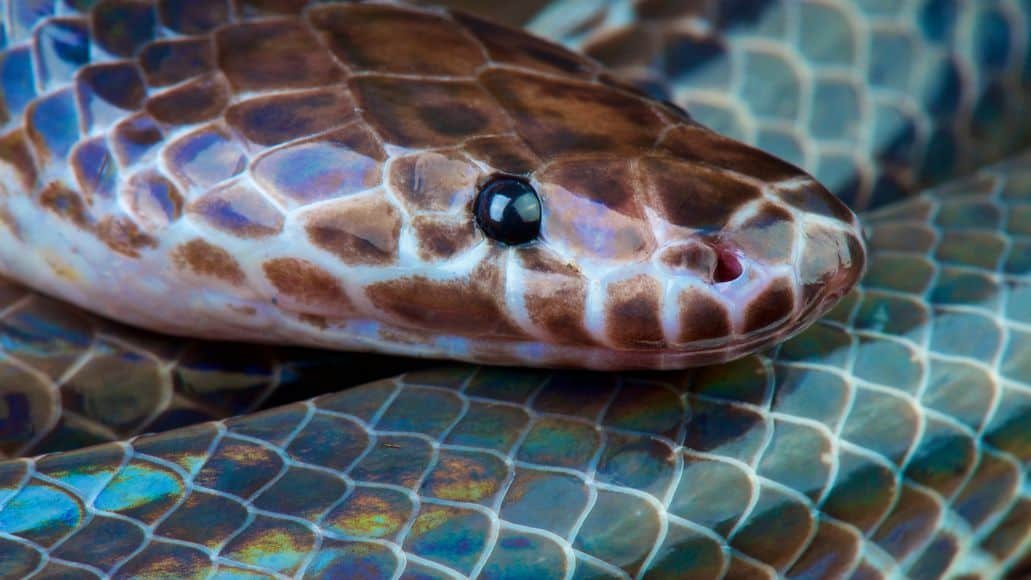
When you see a sunbeam snake, it might not impress you right away. Its body is usually dark brown or black and looks pretty simple at first. Plus, they tend to be covered in mud.
But when the light hits its smooth scales, you’ll notice something special. The scales give off a rainbow-like shine, making the snake look like it’s glowing with many colors—just like a sunbeam.
Sunbeam snakes are native to Southeast Asia. They like to live in moist soil or under leaves, so you might not spot one easily in the wild.
The pattern on a sunbeam snake isn’t about stripes or spots. Instead, its shimmer is what catches your eye. If you ever get the chance to see one, watch how its colors change as it moves. It’s a neat effect, honestly.
8. Rainbow Boa
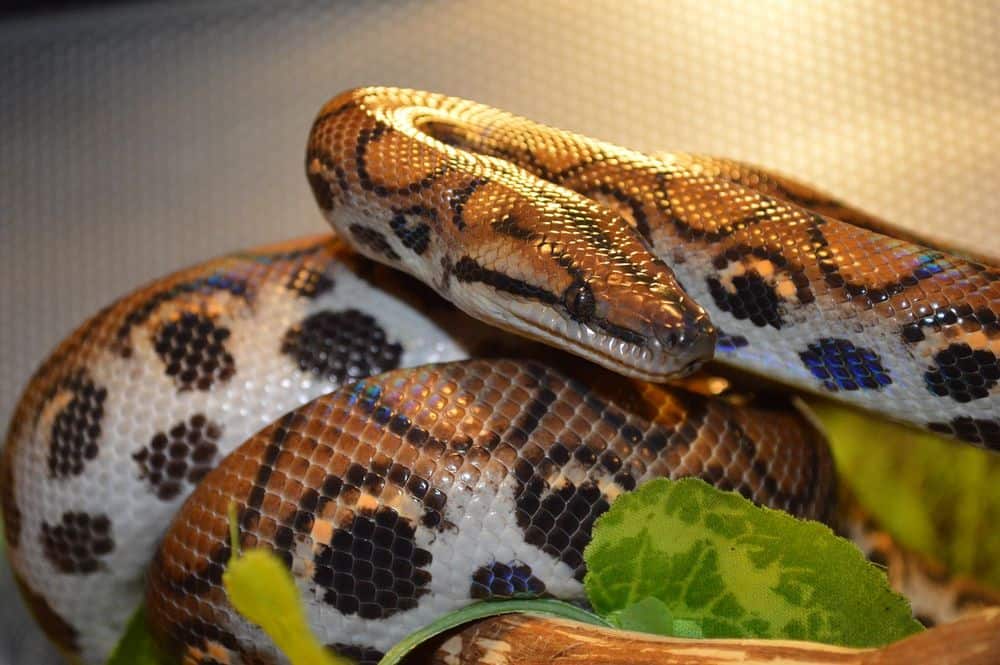
If you look at a rainbow boa, you’ll notice its beautiful colors right away. Its skin shines with a rainbow-like effect when light hits it, making it stand out from many other snakes.
The main color of the rainbow boa is usually brown or reddish, with black rings or spots along its body. These patterns help the snake blend in with the forest floor.
What makes the rainbow boa really special is its iridescence. When you see it from different angles, the snake can look blue, green, or even purple. This effect happens because tiny scales reflect light.
Rainbow boas live in South America, where they spend time both on the ground and in trees. You’ll often find them near rivers or in humid forests. This snake’s calm nature has made it popular with reptile keepers.
If you get a chance to see one, you’ll remember its glowing, colorful look.
9. Mangrove Snake

If you ever find yourself near a mangrove forest in Southeast Asia, you might spot the Mangrove Snake. This snake is sometimes called the Gold-ringed Cat Snake because of its bright yellow bands.
These rings stretch across a shiny, black body, making the pattern easy to recognize. The Mangrove Snake spends most of its life in trees.
You are most likely to see it at night when it hunts for prey. Its bright yellow eyes stand out in the dark, giving it a unique appearance.
You might notice that this snake moves smoothly from branch to branch. The bold lines along its body act as natural camouflage among leaves and shadows.
If you enjoy looking for colorful wildlife, this snake is one you won’t want to miss.
Understanding Snake Pattern Variations
Snake patterns come from a mix of their genes and the environment where they live. These patterns help snakes in real ways, like avoiding predators or blending in to find food.
Genetic Factors Influencing Patterns
The way a snake looks is controlled by its genes. Genes decide if a snake has stripes, bands, blotches, or spots. Mutations can change the color, brightness, or shape of these patterns. Some common genes that affect patterns are shared across snake species.
For example, the melanism gene makes some snakes all black, while the albinism gene removes dark colors.
You might notice these patterns vary even within a single group of snakes. It really shows how genes can act differently in each snake.
Evolutionary Advantages Of Coloration
The colors and patterns on a snake’s body aren’t random. They help snakes survive in the wild. Many snakes use camouflage to blend in, hiding from predators and sneaking up on prey.
Some snakes show off bold, bright patterns to warn other animals. These colors often mean the snake is venomous or tastes bad.
The coral snake’s red, yellow, and black bands are a classic warning signal. Enemies usually get the message and stay away.
Color patterns sometimes help snakes find a mate, too. Brighter or more unique markings can make a snake stand out during mating season.
How To Safely Observe Colorful Snakes
Colorful snakes are fascinating. At the same time, some are fragile or even dangerous. It’s important to watch them safely and respectfully—for your sake and theirs.
Essential Safety Precautions
Before you start exploring, figure out which snake species live in the area. You’ll want to know which ones might be venomous or protected.
Wear long pants and boots if you’re heading into tall grass or rocky spots. It’s just safer that way.
Always keep a safe distance—several feet is best. Binoculars or a camera with zoom let you see details without getting close.
Don’t try to touch, pick up, or trap wild snakes. It’s just not worth the risk.
If a snake bites you, get medical help right away. Carry a basic first aid kit and know the local emergency numbers.
Let someone know where you’re going before heading into wild areas. It’s a simple step that can make a big difference.
Ethical Wildlife Photography Tips
Good wildlife photography means protecting snakes and their homes. Stick to established trails so you don’t damage plants or animal shelters.
Approach snakes quietly and slowly. Loud noises or sudden moves just stress them out.
Use zoom lenses for clear photos from a distance. That way, you stay safe and the snake stays calm.
If the snake looks stressed—maybe it slithers away or flattens its body—back off right away. No photo’s worth upsetting the animal.
Don’t use a flash; it can startle or hurt the snake. And don’t move things to “pose” the animal. Just be patient, respect their space, and leave only footprints behind.
Snakes With Stunning Patterns: Conclusion
It is truly amazing how wildly different snake patterns can be. Some species show off incredibly bright stripes, while others have complex spots or bold bands.
These markings help snakes blend in, warn off predators, or sometimes even attract a mate.
- Snakes like the Gaboon viper have those wild zigzag shapes.
- King snakes show clear, colorful bands that are pretty hard to miss.
- The Green tree python is often covered in scattered spots.
If you ever spot a snake in the wild, just pause for a second and check out its colors and markings. You might notice details you’d usually miss.
Maybe let this nudge you to look a little closer at nature next time. There’s always something weird or wonderful waiting if you pay attention.
Leave a Reply